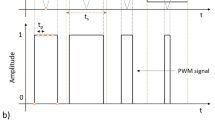Overview
- Authors:
-
-
Paul Tobin
-
School of Electronic and Communications Engineering Dublin Institute of Technology, Ireland
Access this book
Other ways to access
About this book
PSpice for Digital Communications Engineering shows how to simulate digital communication systems and modulation methods using the very powerful Cadence Orcad PSpice version 10.5 suite of software programs. Fourier series and Fourier transform are applied to signals to set the ground work for the modulation techniques introduced in later chapters. Various baseband signals, including duo-binary baseband signaling, are generated and the spectra are examined to detail the unsuitability of these signals for accessing the public switched network. Pulse code modulation and time-division multiplexing circuits are examined and simulated where sampling and quantization noise topics are discussed. We construct a single-channel PCM system from transmission to receiver i.e. end-to-end, and import real speech signals to examine the problems associated with aliasing, sample and hold. Companding is addressed here and we look at the A and mu law characteristics for achieving better signal to quantization noise ratios. Several types of delta modulators are examined and also the concept of time divisionmultiplexing is considered. Multi-level signaling techniques such as QPSK andQAMare analyzed and simulated and 'home-made meters', such as scatter and eye meters, are used to assess the performance of these modulation systems in the presence of noise. The raised-cosine family of filters for shaping data before transmission is examined in depth where bandwidth efficiency and channel capacity is discussed. We plot several graphs in Probe to compare the efficiency of these systems. Direct spread spectrum is the last topic to be examined and simulated to show the advantages of spreading the signal over a wide bandwidth and giving good signal security at the same time.
Similar content being viewed by others
Article
Open access
22 February 2024
Table of contents (7 chapters)
-
Front Matter
Pages i-xiii
-
-
-
-
-
-
-
-
Back Matter
Pages 189-199
Authors and Affiliations
-
School of Electronic and Communications Engineering Dublin Institute of Technology, Ireland
Paul Tobin
About the author
Paul Tobin graduated from Kevin Street College of Technology (now the Dublin Institute of Technology) with honours in electronic engineering and went to work for the Irish National Telecommunications company. Here, he was involved in redesigning the analogue junction network replacing cables with PCM systems over optical fibres. He gave a paper on the design of this new digital junction network to the Institute of Engineers of Ireland in 1982 and was awarded a Smith testimonial for one of the best papers that year. Having taught part-time courses in telecommunications systems in Kevin Street, he was invited to apply for a full-time lecture post. He accepted and started lecturing full time in 1983. Over the last twenty years he has given courses in telecommunications, digital signal processing and circuit theory. He graduated with honours in 1998 having completed a taught MSc in various DSP topics and a project using the Wavelet Transform and neural networks to classify EEG (brain waves) associated with different mental tasks. He has been a ‘guest professor’ in the Institut Universitaire de Technologie (IUT), Bethune, France for the past four years giving courses in PSpice simulation topics. He wrote an unpublished book on PSpice but was persuaded by Joel Claypool (of Morgan and Claypool Publishers) at an engineering conference in Puerto Rico (July 2006), to break it into five PSpice books. One of the books introduces a novel way of teaching DSP using PSpice. There are over 500 worked examples in the five books covering a range of topics with sufficient theory and simulation results from basic circuit theory right up to advanced communication principles. Most of these worked example circuit have been thoroughly ‘student tested’ by Irish and International students and should mean little or no errors but alas. . . He married Marie and has four sons and his hobbies include playing modern jazz on double bass and piano but grew up playing G-banjo and guitar. His other hobby is flying and obtained a private pilots license (PPL) in the early 80’s.




